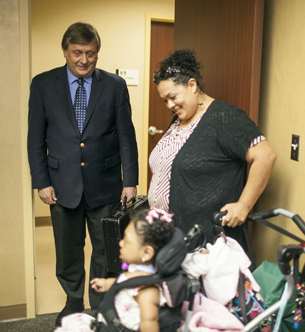 Four years ago, Janelly Martinez-Amador was confined to a bed, unable to move even an arm or lift her head. At age 3, the fragile toddler had the gross motor skills of a newborn and a ventilator kept her alive.
Four years ago, Janelly Martinez-Amador was confined to a bed, unable to move even an arm or lift her head. At age 3, the fragile toddler had the gross motor skills of a newborn and a ventilator kept her alive.
She was born with thin, fragile bones, and by 3, she had no visible bones on X-rays. Initially, doctors weren’t sure she would survive her first birthday. In May, Janelly will turn 7, and is developing bone with the help of an experimental drug therapy and her care team at the Monroe Carell Jr. Children’s Hospital at Vanderbilt.
Now she can dance.
“This is why we get into medicine in the first place,” said her physician, Jill Simmons, M.D., a pediatric endocrinologist at Vanderbilt. “My goodness, to go from no bones to bones. That’s the most impressive thing I have seen as a physician. It’s incredible.”
Janelly has a rare genetic disorder called hypophosphatasia (HPP), a metabolic disease that affects the development of bone and teeth. An enzyme deficiency causes the bones to become soft because they can’t absorb important minerals such as calcium and phosphorus, increasing the risks for pain, broken bones and bone deterioration.
“The treatment has worked very well. If you saw her in 2009 and see her now, it’s not the same Janelly,” said her mother, Janet Amador.
11 children, age 3 years and younger, participated in the clinical trial testing an enzyme-replacement drug therapy, asfotase alfa. Janelly had the worst case of the group.
Michael Whyte, M.D., the lead investigator of the study, visited Janelly and her family at Children’s Hospital last week. It was the first time he had met the family and Dr. Simmons.
“For many years, it seemed there was nothing that was very helpful for this disorder,” said Whyte, medical-science director of the  Center for Metabolic Bone Disease and Molecular Research at Shriner Hospitals for Children in St. Louis.
Center for Metabolic Bone Disease and Molecular Research at Shriner Hospitals for Children in St. Louis.
Varying degrees of HPP affect about one in 100,000 babies born in the United States. The most severe forms occur before birth and half the babies born with the disease don’t survive beyond their first birthday.
“We were fearful that her bone disease was so terribly severe that it might not work. But by looking at the X-rays and hearing about her visits, we were thrilled to hear about her progress,” he added.
About eight months into the treatment, Janelly’s parents felt her fingers — which had been completely soft and boneless — and they could feel traces of developing bone. Her head also began to develop bone. At 18 months into therapy, X-rays showed, for the first time, the visible development of her rib cage.
Janelly now sits in a wheelchair. Recently, dressed in her Easter best and bright pink bows, she was able to turn her head to gaze at a room of onlookers.
She smiled and waved her hand excitedly, a feat she never would have accomplished before the drug therapy. She is also able to attend school at Harris-Hillman Special Education School, not far from Children’s Hospital.
This spring, doctors hope to be able to remove her tracheostomy tube, which has prevented her from speaking. Her developmental and cognitive abilities will be tested in July. Improvement continues each day, each week for Janelly.
Edited by Good News Network; Source materials from Vanderbilt.edu – Photo credit: Vanderbilt-Daniel Dubois
(WATCH her dance in this video below, from the Tennessean)



















